CBORD has announced a partnership with Swipe Out Hunger, a national nonprofit organization working to end college student hunger. The pairing will offer students on CBORD campuses the option to donate meal swipes via the GET CBORD Student mobile app.
Swipe Out Hunger works with colleges and universities across the country in developing sustainable meal donation programs. CBORD will serve as the technology partner, enabling students to donate unused meals from their meal plan to peers experiencing food insecurity on campus from the mobile app.
CBORD’s partnership with Swipe Out Hunger will eliminate the logistical challenges typically associated with similar meal donation initiatives by building on GET’s direct integration with a university’s CBORD campus card system.
Fully integrated meal donation functionality will be released in the GET app this fall semester.
Once students donate meals through the mobile app, donations will be pooled and distributed through each campus card system. Swipe Out Hunger will work directly with those on the ground at CBORD-affiliated institutions to develop thoughtful and accessible programs unique to each campus. Swipe Out Hunger will also advise colleges on best practices as it relates to eligibility and distribution of meal swipes to students experiencing food insecurity.
“Our CBORD customers today have already been accomplishing meal donation via homegrown solutions or via the ordering option in the GET CBORD Student application,” says Rob Wakelee, product owner for GET CBORD Student. “With the redesigned application releasing in late December of 2019, users will have a front and center selection, if their school is opting to incorporate this feature, to clearly display a meal donation option to students.”
CBORD’s cashless system solutions offer complete flexibility for institutions wanting to customize their meal plan programs as necessary.
“With the donation option presented in the GET app, it can be configured to automatically put these swipes to a separate account or pool of funds,” explains Wakelee. “The initial rollout of this feature to the platform will be for the ability for users to donate with later improvements to the program to add support for a request option.”
The GET platform is available to both CS Gold and Odyssey PCS institutions and the meal donation option is no different.
“Any CBORD cashless system institution with a GET platform license can have the donation option turned on at no charge with a call to the help desk,” says Wakelee. “A separate cashless system terminal/location is configured to track meal donations separately from other platform features. This means the donation option can then be enabled or disabled by the institution as needed via the GET admin website.”
It’s been estimated that as many as one-in-three students experiences food insecurity on college campuses today. Swipe Out Hunger is a nonprofit organization that partners with colleges and universities to provide financially and logistically efficient anti-hunger programs.
The organization’s flagship program, “The Swipe Drive,” allows students to donate leftover meal plan swipes to their peers in need.
Swipe Out Hunger’s philosophy is that food should not be a revenue source on a campus where students are going hungry.
“This partnership with CBORD will eliminate a logistical challenge, helping students donate their extra dining hall swipes through this built-in technology solution,” says Rachel Sumekh, CEO and founder of Swipe Out Hunger. “With this function being readily available to students, CBORD is helping campuses implement technology solutions and normalize the practice of adopting programs that support student's basic needs.”
Since being formed as a grassroots movement at UCLA in 2010, the organization has since served 1.7 million meals across 32 states and more than 80 college campuses.
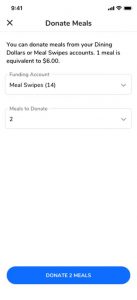 “Swipe Out Hunger’s philosophy is that food should not be a revenue source on a campus where students are going hungry,” says Sumekh.
“Swipe Out Hunger’s philosophy is that food should not be a revenue source on a campus where students are going hungry,” says Sumekh.
“We’re trying to create a model that meets student needs. The financial model of higher education is broken, and it’s a shame that we leave it up to dining services to be profitable,” adds Sumekh. “Change only happens if someone steps up and does something unreasonable.”
The Swipe Out Hunger model varies from campus to campus across its 85-partner network depending on the institution. CBORD-affiliated campuses with the GET platform will now be better positioned to easily launch meal donation programs on campus.
“We believe we have a responsibility as a leading corporation to be bigger than just the bottom line,” says Jeff Wood, vice president of marketing and product at CBORD. “Social responsibility isn’t just a marketing buzzword but a part of our culture.”
“Working with Swipe Out Hunger is an ideal partnership because both organizations have the chance to draw upon their core competencies,” Wood adds. “In CBORD’s case that’s technology, and in Swipe Out Hunger’s case it’s volunteerism and activism. Together we can make substantive progress in the important social issue of student food insecurity.”
The University of Texas at Austin is working with secure identity solutions provider, CLEAR, to deliver a fingerprint access system for fans attending Texas football games.
The partnership will begin with University of Texas football games, and marks the first college athletic program to join CLEAR’s nationwide network. The biometric access solution will enable fast and easy access into Darrell K Royal-Texas Memorial Stadium. Fans simply need to conduct the quick, one-time enrollment, and can then tap their finger and scan their ticket for entry.
“We’re always looking for ways to enhance the fan experience at our athletics venues," said Chris Del Conte, Vice President and Director of Athletics at the University of Texas. "This partnership provides Longhorns fans with a convenient option that will certainly do that while making our stadium operations more efficient."
CLEAR’s lane and enrollment pods will be available next to the stadium's Gate 25 during all remaining regular-season home games. Fans can conduct their free enrollment online at the CLEAR website, as well as find additional information including hours of operation and other FAQ's.
“Launching at DKR-Texas Memorial Stadium is a natural evolution of the work we’ve done to enhance the fan experience at MLB, MLS, NBA, NFL, NHL and WNBA games at iconic venues across the country,” said CLEAR’s Head of Sports Ed O’Brien. “We’re thrilled to partner with the University of Texas to make CLEAR available to Longhorns Fans at this storied institution so they can get into the game faster and easier and enjoy more of what they came to see.”
University students that opt to leverage CLEAR for stadium access will have their own access process. Any student with a valid university email address and government-issued driver’s license or passport can also choose to enroll in CLEAR for free at the venue. Students are also eligible for a CLEAR Plus membership, typically $179/year, at a discounted rate of $50/year for four years. The CLEAR Plus membership provides the same biometric access solution at Austin-Bergstrom International Airport along with the more than 60 locations already in CLEAR’s nationwide network.
Int hat roster of of existing locations, CLEAR is providing its frictionless security solutions U.S. airports, athletics stadiums and other popular venues nationwide. CLEAR’s secure identity platform complies with The National Institute of Standards and Technology (NIST) guidelines for protecting sensitive data and is certified as a Qualified Anti-Terrorism Technology by the U.S. Department of Homeland Security.
Over the coming months, CR80News will be exploring and covering a couple of topics that require some feedback from the industry. We are looking for leads on the following topics and encourage anyone engaging in these areas to share their experiences and lessons learned:
For this area of focus we're looking for campuses that have employed covert personnel in areas affecting the card office or other auxiliaries for the purpose of quality assurance/control, or for other reasons. These so-called mystery shoppers could be interacting with card offices, dining halls, bookstores, events and athletics, or student-facing campus services that fall under the auxiliary umbrella. If this is something that your campus has leveraged, we want to hear about how you've implemented it, where on campus, and what information you were able to glean afterward.
For this topic we're accepting leads pertaining to the use of artificial intelligence as it pertains to the campus card system and auxiliaries. This could be anything ranging from answering questions on your campus card website via a chat bot, to more elaborate implementations that leverage heavy IT involvement.
If your campus is supporting initiatives in either of these two areas, or if you have information that could help us chase down leads, please reach out via email to [email protected].
CR80News was onsite at the 40th annual CBORD User Group Conference (UGC 2019) this week. There were many highlights, great educational sessions, and a packed technology exhibit hall. Here are a few of the highlights.
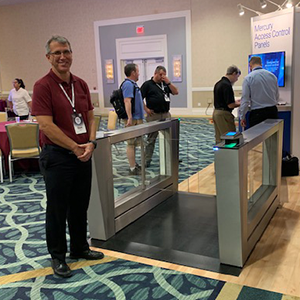 The sleek and secure turnstile from Smarter Security equipped with IDEMIA’s MorphoWave hand scanner was a hit with UGC attendees. The stainless steel and glass unit would look great in any high-end facility. It features anti-tailgating sensors with various alarms to warn staff of suspicious activity. According to Dave Beckwith, CBORD's product manager for integrated security, the primary use case is all-you-can-eat dining facilities. New firmware updates to the MorphoWave biometric scanner increase throughput by 20% and raise the number of patrons that can be enrolled in the unit from 20,000 to 100,000. The system is fully integrated with CBORD’s CSGold platform.
The sleek and secure turnstile from Smarter Security equipped with IDEMIA’s MorphoWave hand scanner was a hit with UGC attendees. The stainless steel and glass unit would look great in any high-end facility. It features anti-tailgating sensors with various alarms to warn staff of suspicious activity. According to Dave Beckwith, CBORD's product manager for integrated security, the primary use case is all-you-can-eat dining facilities. New firmware updates to the MorphoWave biometric scanner increase throughput by 20% and raise the number of patrons that can be enrolled in the unit from 20,000 to 100,000. The system is fully integrated with CBORD’s CSGold platform.
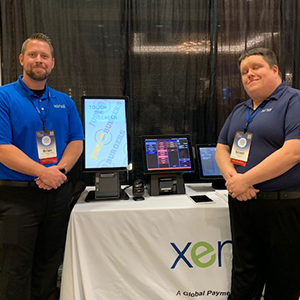 Nextep Systems showcased a series of kiosks for ordering and payment for CBORD food service locations. According to Brian Machiniak, Senior Relationship Manager for Nextep Systems, “self-service at the university level is a demand now.” The company’s range of self-order solutions support multiple methods for order and pay, and Machiniak stresses that flexibility is key because even on the same campus different dining operations require different setups. Nextep has been building self-service kiosks for 15 years, and Machiniak says clients typically see a 15% increase in the average ticket price due to the up-sell capabilities of the devices. Nextep Systems is part of the Xenial group of companies owned by Global Payments.
Nextep Systems showcased a series of kiosks for ordering and payment for CBORD food service locations. According to Brian Machiniak, Senior Relationship Manager for Nextep Systems, “self-service at the university level is a demand now.” The company’s range of self-order solutions support multiple methods for order and pay, and Machiniak stresses that flexibility is key because even on the same campus different dining operations require different setups. Nextep has been building self-service kiosks for 15 years, and Machiniak says clients typically see a 15% increase in the average ticket price due to the up-sell capabilities of the devices. Nextep Systems is part of the Xenial group of companies owned by Global Payments.
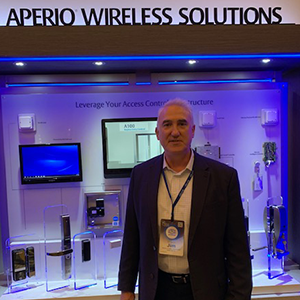 At the CBORD UGC event, Assa Abloy showed a compact version of its Aperio wireless locks that connect to mailboxes. The solution enables campuses to distribute mail to a secured box in a bank of mailboxes and restrict access to only the appropriate student ID card. Jim Primovic, Assa Abloy’s Director of Sales for Campus Electronic Access Control, demonstrated the solution and hinted at a major campus installation underway now.
At the CBORD UGC event, Assa Abloy showed a compact version of its Aperio wireless locks that connect to mailboxes. The solution enables campuses to distribute mail to a secured box in a bank of mailboxes and restrict access to only the appropriate student ID card. Jim Primovic, Assa Abloy’s Director of Sales for Campus Electronic Access Control, demonstrated the solution and hinted at a major campus installation underway now.
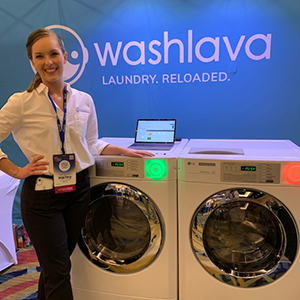 It looks like a glowing hockey puck affixed to a washer or dryer, but the Washlava device indicates when the machine is available, in use, or reserved by another user. Students interact with the laundry solution via a mobile app, reserving and paying for cycles. If they are standing in front of a machine, Bluetooth communication from their phone to the puck handles the transaction. They can also use the app to reserve a machine from their dorm or other location, locking it down for a specific number of minutes. According to Washlava's Hailey Hendrickson, MIT students pay for laundry cycles using their ID card's TechCash via MIT's CBORD system.
It looks like a glowing hockey puck affixed to a washer or dryer, but the Washlava device indicates when the machine is available, in use, or reserved by another user. Students interact with the laundry solution via a mobile app, reserving and paying for cycles. If they are standing in front of a machine, Bluetooth communication from their phone to the puck handles the transaction. They can also use the app to reserve a machine from their dorm or other location, locking it down for a specific number of minutes. According to Washlava's Hailey Hendrickson, MIT students pay for laundry cycles using their ID card's TechCash via MIT's CBORD system.
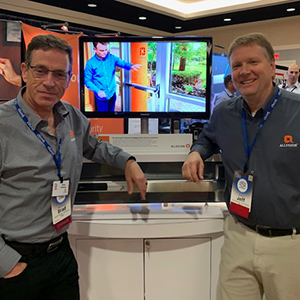 Crash bars are the metal locking mechanisms that span the width of many public access perimeter doors. Von Duprin is an industry leading provider of crash bars supplying 70% of the units in the higher education market, says Jeff Koziol, business development manager, campus software partner at Allegion. Allegion developed a retrofit kit for the popular crash bar that greatly improves campus safety. In normal operation, a staff person visits these doors and unlocks them so that students have unfettered access during normal operating hours. This unlocking process is known as “dogging” the doors. At the end of the day, the staff member goes back and “undogs” the doors, returning them to their locked state. Access control readers then require card access for entry. With the Allegion retrofit kit, Koziol explains that the undogging process can be automated such that many doors can be relocked from a central location. CBORD has integrated this new Allegion feature into CSGold.
Crash bars are the metal locking mechanisms that span the width of many public access perimeter doors. Von Duprin is an industry leading provider of crash bars supplying 70% of the units in the higher education market, says Jeff Koziol, business development manager, campus software partner at Allegion. Allegion developed a retrofit kit for the popular crash bar that greatly improves campus safety. In normal operation, a staff person visits these doors and unlocks them so that students have unfettered access during normal operating hours. This unlocking process is known as “dogging” the doors. At the end of the day, the staff member goes back and “undogs” the doors, returning them to their locked state. Access control readers then require card access for entry. With the Allegion retrofit kit, Koziol explains that the undogging process can be automated such that many doors can be relocked from a central location. CBORD has integrated this new Allegion feature into CSGold.
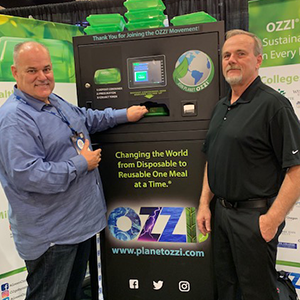 Around the world and on our campuses, the war against single use plastic is being waged. To-go containers from campus dining locations are a prime campus target. OZZI’s system of reusable containers and collection kiosks is already helping 90 colleges and universities eliminate waste and save money. “One OZZI container can replace 300 single use containers,” says Tom Wright, OZZI CEO. “An OZZI container costs less than $5 while each single use container costs 20-30 cents.” Campuses save money and help the environment. Typically a student redeems a token for a clean container and receives a token back when they return a dirty container to an OZZI kiosk. At the UGC event, OZZI demonstrated how CBORD has created a virtual token stored in the student card system, eliminating the need to keep track of physical tokens.
Around the world and on our campuses, the war against single use plastic is being waged. To-go containers from campus dining locations are a prime campus target. OZZI’s system of reusable containers and collection kiosks is already helping 90 colleges and universities eliminate waste and save money. “One OZZI container can replace 300 single use containers,” says Tom Wright, OZZI CEO. “An OZZI container costs less than $5 while each single use container costs 20-30 cents.” Campuses save money and help the environment. Typically a student redeems a token for a clean container and receives a token back when they return a dirty container to an OZZI kiosk. At the UGC event, OZZI demonstrated how CBORD has created a virtual token stored in the student card system, eliminating the need to keep track of physical tokens.
Entrust Datacard's Dan Sanden gives a hands-on demonstration of the differences between retransfer and direct-to-card printing. See the company's SD460 direct-to-card offering, the flagship CR805 retransfer printer, and the customization options that campuses can add to both machines to achieve the perfect card aesthetic.
In the video, learn about the key differences between both printing methods and key factors your card office should consider when making the decision between retransfer and direct-to-card printing. Sanden also discusses how campuses can add laminates for increased durability, as well as opt for a tactile die that heat presses a custom seal into the card's laminate for an added visual security and branding element.
The University of Idaho recently implemented preferred names on its student ID, the VandalCard. But the university has since briefly paused the service as it decided to revisit both state and federal ID compliance considerations.
According to an official university release, campus administrators felt that the legal implications of the student ID card needed to be revisited as it pertained to the display of a non-legal name. After some deliberation, the VandalCard office determined that the inclusion of a legal statement on the back of the VandalCard would be sufficient to meet some common identification concerns such as fraud.
As with many universities, Idaho's VandalCard is the official form of identification card for students, staff, faculty and affiliated persons. The VandalCard is used for accessing campus buildings and facilities, student computing labs, events, dining plans, the Student Health Center and the library. It is also required to obtain a financial aid check. VandalCards also remain valid for as long as the cardholder is an active student or employee.
Many campus cards carry these same privileges and access capabilities, and the addition of legal language to a student ID card is commonplace. However, the added legal language on VandalCards bearing a preferred name has raised questions from some students.
According to a report from the University of Idaho's student publication, The Argonaut, the language added to the front of VandalCards will read “Not for official identification” and the back of VandalCards will read “The name shown on this card may not be the holder’s legal name.”
Beginning this week all VandalCards will be printed with this additional language regardless of whether the student, faculty or staff uses a preferred name or not.
The decision to add the legal disclaimers means that the cards already issued and in circulation with preferred names have to be replaced. Per the Argonaut's reporting, this has led to a few students expressing frustration having already received a VandalCard bearing their preferred name.
The general best practices for the implementation of preferred names varies, with some campuses choosing to print preferred names on the front and legal names on the back, while others print only a preferred name. For more on preferred name policies and implementations, check out our previous coverage on the topic.
It's been roughly two months since Starship Technologies and its band of roving, autonomous delivery robots arrived on the Purdue University campus. The excitement and intrigue of the initiative has settled, so what does the day-to-day operation look like?
According to a report from Purdue's student publication, The Exponent, the initial response to Starship Technologies' delivery robots was strong, with one campus Starbucks alone processing some 20 robot delivery orders per four-hour shift.
That Starbucks is one of nine locations at Purdue that currently processes Starship delivery orders. The early success of robot delivery has even changed the workflow of the coffee shop.
“Every day we come in we have a different position we’re assigned to, and we just added the robot position,” said Amy Rappa, Purdue student and barista at the Starbucks, in an Exponent interview.
The so-called “robot runners” are notified of orders placed for Starship delivery through the app on Starbucks iPads and phones. After prepping the order, the employee places it inside the Starship robot, taps the completed order button on the Starship app and the robot begins its journey.
Since going live, the number of Starbucks orders places for robot delivery has settled down closer to ten per four-hour shift. But it's worth noting that this is just one of the participating merchants, and there's more features that could be added to the program soon.
One such addition that could drive the number of robot delivery orders higher is the acceptance of funds from Purdue's declining balance account on the Purdue ID.
“Right now they’re trying to find a way to include Dining Dollars and Boiler Express to Starship," Rappa told the Exponent. "I think if that were to happen, the popularity would probably rise again."
Using a system of cameras, sensors and machine learning, the robots have the ability to navigate sidewalks and a variety of terrain without colliding with pedestrians or other obstacles. In total, each Starship robot houses ten cameras that track terrain to the nearest inch, sirens that sound if the chassis is tampered with, and a lid that remains locked at all times until the user opens it with their order code.
Despite being a fully featured system, there are times when the robots need a helping hand. Should a delivery robot ever get stuck, Starship leans on its human employees to troubleshoot.
The company employs human operators at offices in Washington D.C., Arizona and Virginia. Each human operator monitors numerous robots, and can take control if a robot has been waiting for a certain period of time, for example on a crowded sidewalk or at a busy intersection.
Purdue University's fleet of Starship robots is the largest on a college campus to date, and joins a roster of other early adopters that have experienced success with the initiative. A spokesperson for Starship Technologies says the company has plans to launch its robot delivery system on as many as 100 college campuses over the next two years.
Binghamton University has set an end-of-life date for its single use to-go containers on campus, with a planned implementation of the OZZI system in January. The move to OZZI's reusable container system is driven by the university's desire to boost its sustainability efforts and will provide every student on a campus board plan with a free buy-in to the program.
As reported by Binghamton student publication, Pipe Dream, the university's Student Culinary Council and Binghamton University Dining Services together decided on the OZZI system which consists of a return machine and reusable plastic to-go containers.
Each student that purchases a meal plan will receive one free OZZI token which can be exchanged for a takeout container for use at campus dining halls. Students will be given a clip-on token holder for safe keeping. Once the student is done with the dirty container they simply return it to the OZZI machine to receive a new token for future use.
Binghamton is making the OZZI machines readily available to students in all of its undergraduate living communities. In total, the initiative will see five OZZI machines deployed across campus where students can return their plastic containers and receive their next token.
Sustainability is the primary reason behind Binghamton's use of the OZZI system. “One of the beauties of our meal plans is the ability of students to take their food out,” said Jim Ruoff, resident district manager for BUDS, in a Pipe Dream interview. “I think students like it — they use it — I want to make that more environmentally friendly.”
“We use thousands of these carryout containers a week that end up in our waste stream,” Ruoff added. “I would love to cut that to zero. That’s my dream. I think that would be a real positive for our community.”
The OZZI system has been implemented at a number of other colleges and universities. Many of OZZI's university clients are leveraging the metal token method for checking out the containers, though the University of California Merced has experienced success in integrating OZZI with its campus card system and leveraging the student ID card for container checkout.
Binghamton officials hope to have the OZZI initiative running at full capacity by the first day of the spring semester, January 19.
Penn State is developing a new, all-in-one mobile campus app that administrators hope will better connect students to the university and help them discover campus events and services. The app will be named Penn State Go and is the product of a University-wide initiative to improve the student experience through increased access to key resources.
According to an official university release, the Penn State Go mobile app will be released for the start of the spring 2020 semester. The app will contain all the necessary components for students and other members of the Penn State community to navigate life on campus.
Some of the notable features in Penn State Go include:
Throughout the development process, students participated in online surveys and in-person focus groups to provide feedback on possible features included in a Penn State campus app. That feedback also led to the selection of 'Penn State Go' as the app’s official name.
Still in its beta phase, Penn State Go is currently accepting student feedback as campus administrators continue to refine the app's aesthetic and user experience. A desktop version of Penn State Go will also be launched in spring 2020, and will include all the same features as the mobile app in browser form.
Entrust Datacard's Dan Sanden delves into detail about TruCredenial, the company's browser-based card issuance software, and how it can help campuses bust up long lines and distribute ID card issuance in a flexible manner.
In the video Sanden describes how the browser-based approach of TruCredential enables campus card offices to issue student credentials anytime, anywhere. The software helps card offices to design and issue new ID cards quickly with intuitive, drag-and-drop design templates and workflows, and offers a wide array of customization options.
See the issuance process in action as Sanden provides a step-by-step walkthrough using an off the shelf tablet to support photo capture and student information acquisition. Finally with finished product in hand, hear about the benefits of true over the edge card printing and card durability that's achieved using retransfer printing techniques.

